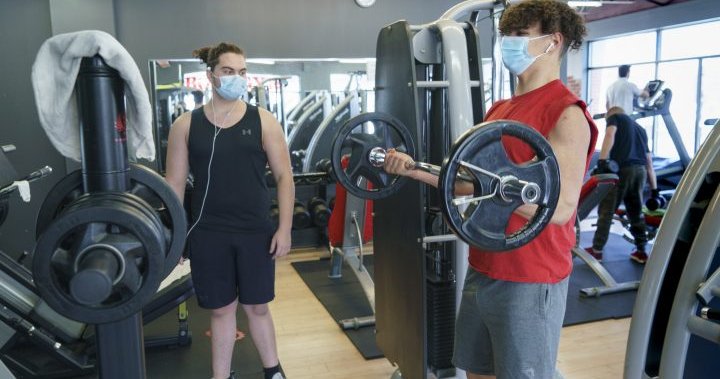As coronavirus cases stabilize across the country, some provinces are easing COVID-19 restrictions this week, allowing Canadians greater freedom to exercise.
In Quebec, starting Monday, residents in five regions will be able to eat in restaurants and work out in gyms. Meanwhile, team sports activities can now resume across New Brunswick.
Read more:
Double masking or 3-layer mask with filters? Experts weigh in as COVID-19 variants spread
Last week, Alberta also said unsupervised, low-intensity individual and group exercises would be allowed by appointment in indoor facilities.
Since the start of the pandemic, the World Health Organization (WHO) has recommended against wearing face coverings while exercising as a wet mask from your sweat may make it difficult to breathe and promotes the growth of microorganisms, it says.
However, some research suggests wearing a mask even during intense exercise is safe for healthy people, with only a slight reduction in performance and an increase in carbon dioxide levels.
Results of a peer-reviewed study published in the European Respiratory Journal on Sunday showed that there were no adverse effects of exercising while masking in a trial of 12 adults — six men and six women — that underwent three cardiopulmonary exercise tests.
“If you have a certified mask which allows airflow, even with increased resistance, and you are healthy, then the only problem is a reduction in performance,” said Dr. Piergiuseppe Agostoni, co-author of the study and a professor of cardiology at the University of Milan.

However, a non-certified homemade mask, which can impede airflow and cause higher carbon dioxide retention, can lead to problems and be “dangerous,” he added.
Another study in September 2020 done in Israel, including 16 healthy, non‐smoking young adult men, had similar results.
It showed that wearing either a standard surgical mask or the heavy-duty N95 mask did not have a significant impact on the heart rate, respiratory rate, blood pressure, oxygen saturation and time to exhaustion during low-, moderate- or high-intensity aerobic training.
[ Sign up for our Health IQ newsletter for the latest coronavirus updates ]
The only physiological difference noted by the authors was that the N95 mask caused a significant increase in the carbon dioxide levels being exhaled with each breath.
“I think individuals can still safely attend a fitness facility and wear a mask,” said Amy Kirkham, assistant professor of clinical cardiovascular health at the University of Toronto.
However, she noted that people with underlying lung problems, such as chronic obstructive pulmonary disease, were at an increased risk when wearing a mask while walking.

In Quebec’s gyms, people are allowed to take their masks off while they exercise but are asked to keep them on when moving from one device to another.
While masks can become wet during exercise with high breathing rates, Kirkham said there are ways to reduce the negative impact to enable people to work out in indoor public fitness facilities while wearing them.
“You can try to limit the intensity or the duration or both of cardiovascular exercise inside a fitness facility and this will limit how wet the mask becomes,” Kirkham told Global News.
Regularly changing the mask as it becomes wet while exercising can be helpful, she said.
Kirkham also recommended doing strength training and yoga, which do not increase your heart rate as much as running, inside gyms, and taking the more intense cardiovascular exercises outdoors, which can be done without a mask on, but while maintaining a safe physical distance of at least two metres.
If you do feel shortness of breath, reduce the intensity or take a break, she said, and stop exercising if you start to feel symptoms associated with respiratory acidosis, such headache, confusion, vomiting and disorientation.

© 2021 Global News, a division of Corus Entertainment Inc.


